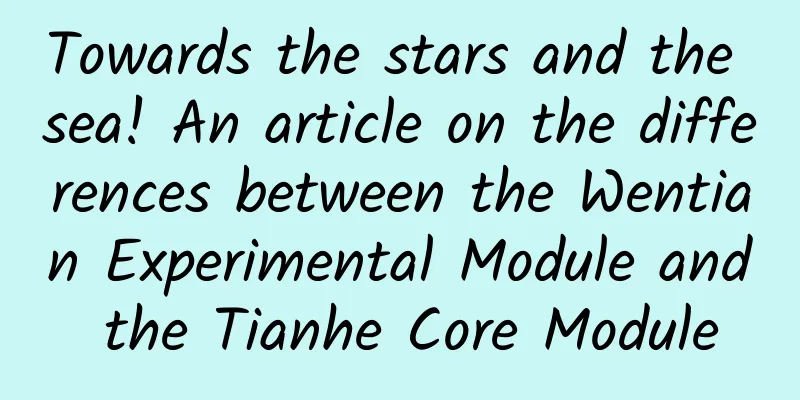Towards the stars and the sea! An article on the differences between the Wentian Experimental Module and the Tianhe Core Module

|
Two years ago, on July 23, 2020, the Long March 5 Yao-4 carrier rocket took off from the Wenchang Space Launch Center, carrying the Tianwen-1 Mars probe, and embarked on the long road of exploring Earth's close neighbor - Mars. Image source see watermark Two years later, also at the Wenchang Space Launch Center, the Long March 5B carrier rocket sent the Wentian laboratory module into space. Part 1 In addition to turning the space station into a "two-cabin" space station, Wentian also shoulders the important mission of scientific experiments. "Tianwen" and "Wentian" are only different in order, but they are both taken from the long poem "Heavenly Questions" by the famous poet Qu Yuan. The beautiful imagination of the universe by people living in China from ancient times to the present is gradually becoming a reality today: the "Tianwen-1" probe has landed on Mars for more than a year, bringing us first-hand information about the red planet; and the "Wentian" experimental module will go to the "Tiangong" space station in the future and dock with the "Tianhe" core module. The planned "three-module" configuration will be completed with "two modules", and the scale of China's "Tiangong" space station will be further expanded . The Chinese space station with three cabins is like this my country's Tiangong space station is mainly a "space laboratory". Various scientific experiments will be carried out in it to study the short-term and long-term effects of the space environment on physics, chemistry, biology and medicine, providing a theoretical and technical basis for us to go deeper into space. Since it is a "space laboratory", it must need a large number of experimental instruments. The main functions of the existing Tianhe core module are the main control of the space station, the long-term stay of astronauts and the docking core of each module. Therefore, the number of experimental cabinets on it is relatively limited, and only a small number of experiments can be carried out. The protagonist of this time, the "Wentian" laboratory module, as the name suggests, is mainly responsible for conducting space experiments. Part 2 A picture shows the difference between the Wentian experimental module and the Tianhe core module Comparison of the Wentian Experimental Module and the Tianhe Core Module / Produced by: Xingzhi Science and Technology Its structure is significantly different from the core module: First of all, the eye-catching "head". The head of the Tianhe core module is a round node module with two docking ports, two berthing ports and one exit port. The head of the Wentian experimental module is a pointed resource module, equipped with two large flexible solar panels made of the same material as the Tianhe core module, but with a significantly larger area. There are many cabinets in the experimental module, and the energy consumption demand also increases accordingly, so a larger area of solar panels is needed to provide more abundant electricity. It is worth pointing out that a solar wing installation interface is reserved at the top of the solar wing truss. After the space station is built, a solar wing located in the Tianhe core module can be transferred to this interface to further improve the lighting efficiency (the other one can be installed to the interface of the Mengtian experimental module). We can also notice that the relay antenna of the Wentian experimental module is also arranged on the resource module, while the relay antenna of the Tianhe core module is on the large column section. In addition, the functions of the two resource modules are basically similar, both of which have attitude adjustment and energy storage functions. Below the “head” is the “middle part”. The middle part of the Tianhe core module is a small column section with a diameter of 2.9 meters, where the astronauts' sleeping and sanitary areas are located, as well as a "space treadmill"; while the middle part of the Wentian experimental module is a square airlock cabin. The sleeping area, sanitary area and space treadmill of the small column section of the Tianhe core module Although the Tianhe core module also has an airlock (i.e. node module), the Tianhe's airlock is smaller than the Wentian's airlock in terms of volume and exit diameter, making it inconvenient for astronauts to carry out extravehicular activities. More importantly, once the Tianhe airlock begins its extravehicular mission, the cabin will be evacuated, losing its function as a node cabin, and the various cabins cannot be transferred. While causing inconvenience, it also poses certain hidden dangers. Therefore, the Wentian airlock will serve as the main airlock for astronauts to carry out extravehicular activities in the future , while the Tianhe airlock will serve as a backup. Once the main airlock fails, astronauts can also enter and exit from the backup airlock. The airlock of "Wentian" is also equipped with an extravehicular exposure platform , which facilitates the exposure of various samples to the space environment and studies the impact of the extreme space environment on various materials, parts and even life forms, further broadening the scope of research. Below the "middle" part is the main body of the cabin, which is cylindrical with a diameter of 4.2 meters. The main body of the "Tianhe" core module is called the "large column", which includes a part of the life control module and a resource module; while the main body of the "Wentian" is a complete working module. In addition to a large number of experimental cabinets, it is also equipped with 3 sleeping areas and 1 sanitary area. Once assembled, it will be able to meet the needs of the "Shenzhou 14" and "Shenzhou 15" crews, totaling 6 astronauts, for a reunion in space, in conjunction with the 3 sleeping areas and 1 sanitary area already in the "Tianhe" core module. In addition to the living space, the Wentian laboratory module also has a backup control and management system for the Tianhe core module, which serves as a redundant function. In an emergency, the entire space station can be controlled through the laboratory module to ensure the safety of the spacecraft and astronauts. A small robotic arm is also installed on the outside of the "Wentian" experimental cabin. Although the core module of Tianhe has a large robotic arm, and its range of motion and load-bearing capacity are greater than the small robotic arm of Wentian, it is slightly inferior in precision and flexibility. Fortunately, the large and small robotic arms can be cascaded, thus realizing the function of "1+1>2". The combined robotic arm not only has a larger and more flexible range of motion, but also has a higher level of precision. Astronauts can operate the robotic arm in the cabin to transfer the load outside the cabin without leaving home, reducing the number of extravehicular activities and improving work efficiency. Schematic diagram of the collaboration between the large and small robotic arms/Source: Xingzhi Science and Technology After the Wentian experimental module docks with the Tianhe core module, it will remain at the forward docking port for the next three months, forming an "I"-shaped main structure together with the Tianzhou cargo spacecraft parked at the rear of the Tianhe core module. At the same time, the Shenzhou 14 manned spacecraft will be parked at the side docking port, giving the space station an "Bu"-shaped configuration as a whole. Image source: Star Intelligence When the "Mengtian" laboratory module heads for space three months later, the "Wentian" laboratory module will, with the assistance of the transfer robotic arm, move from the front docking port to the side docking port to make room for the "Mengtian" laboratory module. Subsequently, the "Mengtian" laboratory module will also be transferred, and finally complete the tasks of the "Tiangong" space station construction phase. Part 3 Carrying the questions raised by the ancients and modern people, we set out towards the sea of stars! The Miluo River flows endlessly, and the waves of the South China Sea remain unchanged. From Zigui to Wenchang, it is more than 2,000 miles, and from "Heavenly Questions" to "Asking the Heaven", it has been more than 2,000 years. The vast land has shaped our broad mind, and the long history has forged our lofty pursuits. Continuously marching into space and persisting in exploring the unknown is the best answer we can give to our ancestors. Image source: Star Intelligence Produced by: Science Popularization China Author: Frozen Sunflower Producer: China Science Expo The article only represents the author's views and does not represent the position of China Science Expo This article was first published in China Science Expo (kepubolan) Please indicate the source of the public account when reprinting Please indicate the source of the reprint. Reprinting without authorization is prohibited. For reprint authorization, cooperation, and submission matters, please contact [email protected] |
Recommend
Will Android become history? Google is launching a new operating system
The market share of Android system continues to e...
Alipay Mini Program is here! This may be Alibaba’s most important strategy after Jack Ma announced his resignation!
[[243459]] There is a saying in the Internet indu...
Xiaomi App Store CPD Cooperation Introduction
1. Platform Introduction 1. Service Introduction ...
What exactly do the cool people in conspiracy theories want to do?
[[138341]] Coolpad is a powerful company, and Chi...
Why didn't a larger iPad appear this year?
In the early morning of October 17th, Beijing tim...
Can Google still make a living if it returns to the Chinese market?
Recently, there is news that Google has made a pr...
What you think is "getting angry" may be a warning sign of cancer! Don't just bear these 4 symptoms if they don't heal for a long time
Ms. Wang, 30 years old, has recently had frequent...
APP UI design trends: moving for good design
Pleasing animation has become a must for an app, ...
Gionee Marathon M3 released: equipped with 5000mAh battery
The mobile phone industry is ever-changing. Nowad...
How much does it cost to attract investment in the Bengbu Tea Mini Program? What is the investment price of Bengbu Tea Mini Program?
The overall investment promotion of Bengbu Tea Mi...
Promoting activation and retention: analysis of user growth system design
1. What is the user growth system? The evolution ...
The K12 material optimization and delivery guide is released!
As the epidemic situation stabilizes, primary and...
There are so many benefits of staying in bed in winter! Even doctors recommend it!
Source: Life Times Review|Li Nannan Director of H...
The underlying logic of event planning and promotion!
Operational activities are one of the common meth...
How to write an excellent marketing plan?
Many people who work in operations have experienc...









